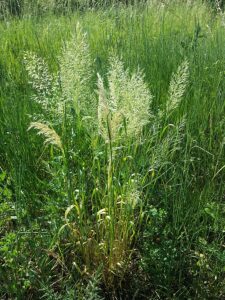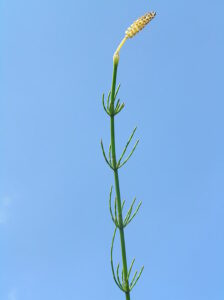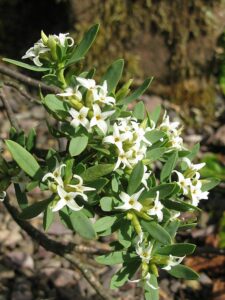Poisonous plants for horses can grow everywhere. Especially when grazing and riding out, you should bear in mind that horses are one of the most sensitive species when it comes to intoxication by certain plants. Many toxic plants emit an unpleasant odour or taste very bitter, so horses usually intuitively avoid them anyway. This article tells you everything you need to know about poisonous plants for horses.
Are horses likely to eat poisonous plants?
Nevertheless, under certain circumstances horses may ingest poisonous plants. The following horses or situations in particular can result in the horse poisoning itself:
- Young, inexperienced horses are not yet able to assess the danger.
- Extremely hungry horses will also eat poisonous plants.
- When pastures have been grazed, only poisonous plants remain, which the horses then eat.
- Poisonous plants are often found along the path during rides.
There are now about 450 known poisonous plants in Germany. But new ones are constantly being added because more and more exotic plants are finding their way into gardens. The plants are not all equally toxic. The toxicity of the plants also depends on the season, weather, sunlight, soil conditions, fertilisation and parasite infestation. Hay can also contain poisonous meadow plants such as meadow saffron, and they have a toxic effect there as well.
Typical symptoms when your horse has consumed poisonous plants
There are different symptoms that a horse shows when poisoned. Look out for the following signals:
Possible signs:
- Restlessness, agitation
- Apathy
- Altered pupils
- Constipation
- Diarrhoea
- Cramp-like colic attacks
- Loss of balance,
- Possibly paralysis of the pharynx, in which case saliva runs out of the mouth
Treatment of poisoning
If the vet knows the particular plant that has led to the poisoning, he can initiate appropriate treatment measures. For example, administering activated charcoal or emptying the stomach. Treatment becomes more difficult if the poisonous plant is unknown. Then, for example, the stomach contents have to be examined.
Overview of poisonous plants for horses
Common toxic plants – grassland plants
Bracken
 The bracken fern has its origins all over Europe. Mostly, the plant is found in forests, wooded meadows, open fields and poorly maintained pastures. The poisonous fern can also be ingested via hay or silage. The leaves contain the highest concentration of poison. Toxins are thiaminase, hydrocyanic acid glycosides and saponin. 2-3 kg over a period of 30 days can be fatal for the horse. Signs are nervous disorders, cramps or blood urine.
The bracken fern has its origins all over Europe. Mostly, the plant is found in forests, wooded meadows, open fields and poorly maintained pastures. The poisonous fern can also be ingested via hay or silage. The leaves contain the highest concentration of poison. Toxins are thiaminase, hydrocyanic acid glycosides and saponin. 2-3 kg over a period of 30 days can be fatal for the horse. Signs are nervous disorders, cramps or blood urine.
Golden oat grass

Stefan.lefnaer, CC BY-SA 4.0, via Wikimedia Commons
Golden oat grass is found in large parts of Europe, mostly on extensively cultivated land. The trigger for the poisoning is a vitamin D-like substance (glycoside). Excessive intake can lead to vitamin D poisoning. Symptoms can include kidney damage, vascular calcification and apathy.
Meadow saffron
 This plant is widespread in Europe. It is found in damp meadows and pastures and resembles wild garlic. The seeds and bulb of the plant are particularly poisonous. They contain the poisonous substance colchicine. The green leaves also remain poisonous for years in the hay. 50 grams of the fresh herb can already be fatal. Symptoms of poisoning in horses with this plant are refusal to eat, respiratory paralysis, colic, bloody diarrhoea or brown urine.
This plant is widespread in Europe. It is found in damp meadows and pastures and resembles wild garlic. The seeds and bulb of the plant are particularly poisonous. They contain the poisonous substance colchicine. The green leaves also remain poisonous for years in the hay. 50 grams of the fresh herb can already be fatal. Symptoms of poisoning in horses with this plant are refusal to eat, respiratory paralysis, colic, bloody diarrhoea or brown urine.
Ragwort
 Ragwort has only been found on German pastures for a few years. The plant is poisonous due to various pyrrolizidine alkaloids. These lead to chronic liver poisoning. It is also poisonous in hay. An intake of 4-8% of the horse’s body weight can be fatal. Symptoms are listlessness, liver damage or jaundice of the horse.
Ragwort has only been found on German pastures for a few years. The plant is poisonous due to various pyrrolizidine alkaloids. These lead to chronic liver poisoning. It is also poisonous in hay. An intake of 4-8% of the horse’s body weight can be fatal. Symptoms are listlessness, liver damage or jaundice of the horse.
Meadow buttercup
 This yellowish plant occurs in Europe, Asia and North America. It can often be found in meadows and pastures. The roots of the meadow buttercup are also poisonous. The plant contains the toxins protoanemonin, anemonin and saponins. Because of the pungent taste, most horses avoid the plant. Symptoms of poisoning would be diarrhoea, nervous system disorders and salivation.
This yellowish plant occurs in Europe, Asia and North America. It can often be found in meadows and pastures. The roots of the meadow buttercup are also poisonous. The plant contains the toxins protoanemonin, anemonin and saponins. Because of the pungent taste, most horses avoid the plant. Symptoms of poisoning would be diarrhoea, nervous system disorders and salivation.
Marsh horsetail

Petr Filippov, CC BY-SA 3.0 , via Wikimedia Commons
The marsh horsetail occurs throughout Europe. The plant occurs on banks, in wet meadows or in swamps. The plant is highly toxic due to alkali, traces of nictoin, aconitic acid, and the enzyme thiaminase. 20% of marsh horsetail in hay can lead to the death of the horse after 30 days of feeding. Possible signs of poisoning are staggering, jumpiness or dilated pupils of the horse.
Foxglove
 Foxgloves are well known in Europe and are mostly found in forest clearings, forest edges or gardens. They contain the toxin digitalis glycosides, which is highly toxic to horses. As little as 25 grams of dried foxglove can be fatal. Or even 100 grams of the fresh plant can be life-threatening for the horse. Symptoms are drowsiness, heart disorders and bloody diarrhoea.
Foxgloves are well known in Europe and are mostly found in forest clearings, forest edges or gardens. They contain the toxin digitalis glycosides, which is highly toxic to horses. As little as 25 grams of dried foxglove can be fatal. Or even 100 grams of the fresh plant can be life-threatening for the horse. Symptoms are drowsiness, heart disorders and bloody diarrhoea.
Common toxic plants – Landscaping at equestrian facilities
Boxwood
 Boxwood is native to southwestern Europe, central Europe, northern Africa and western Asia. It is often found as a hedge in gardens, rarely in deciduous forests. It contains about 70 alkaloids that are poisonous. The plant is therefore highly poisonous to horses. 700 to 900 grams of leaves or bark are already fatal for the horse. Signs of poisoning are paralysis, colic or dizziness.
Boxwood is native to southwestern Europe, central Europe, northern Africa and western Asia. It is often found as a hedge in gardens, rarely in deciduous forests. It contains about 70 alkaloids that are poisonous. The plant is therefore highly poisonous to horses. 700 to 900 grams of leaves or bark are already fatal for the horse. Signs of poisoning are paralysis, colic or dizziness.
Beech
 The beech tree has its origins in large parts of Europe. Mostly, the plant is found in forests, pasture edges and in villages along roadsides. Especially the fruit, called beech nuts, are very poisonous for horses. They contain the toxic substances saponins and oxalic acid. These have a high degree of toxicity for horses and are already fatal from 300g. Symptoms are colic, cramps or paralysis.
The beech tree has its origins in large parts of Europe. Mostly, the plant is found in forests, pasture edges and in villages along roadsides. Especially the fruit, called beech nuts, are very poisonous for horses. They contain the toxic substances saponins and oxalic acid. These have a high degree of toxicity for horses and are already fatal from 300g. Symptoms are colic, cramps or paralysis.
Yew
 The yew is undoubtedly one of the most poisonous plants of all. Yew trees are usually found in gardens and forests. They are also often found next to horse pastures. They are highly poisonous due to ingredients such as Taxin B. Bark, needles and seeds are highly poisonous to horses. As little as 100 grams can be fatal. The poison leads to heart and respiratory paralysis.
The yew is undoubtedly one of the most poisonous plants of all. Yew trees are usually found in gardens and forests. They are also often found next to horse pastures. They are highly poisonous due to ingredients such as Taxin B. Bark, needles and seeds are highly poisonous to horses. As little as 100 grams can be fatal. The poison leads to heart and respiratory paralysis.
Oleander
 Oleander is native to Europe and the Mediterranean region. The plant is found in parks or gardens and often used as decoration on farms or at horse shows. It contains the heart-active gylcoside oleandrin, which causes a high degree of toxicity in horses. Already 15-20 g of the leaves are lethal for horses. Symptoms are a drop in body temperature and respiratory paralysis.
Oleander is native to Europe and the Mediterranean region. The plant is found in parks or gardens and often used as decoration on farms or at horse shows. It contains the heart-active gylcoside oleandrin, which causes a high degree of toxicity in horses. Already 15-20 g of the leaves are lethal for horses. Symptoms are a drop in body temperature and respiratory paralysis.
Rhododendron
 The rhododendron is found in Europe, Asia and North America, in gardens and parks and also flowers in winter. The leaves, nectar and pollen of the plant are particularly poisonous. These contain the toxins andromedotoxin and grayanotoxin. Signs of poisoning are irritation of the mucous membranes, salivation or bloody diarrhoea of the horse.
The rhododendron is found in Europe, Asia and North America, in gardens and parks and also flowers in winter. The leaves, nectar and pollen of the plant are particularly poisonous. These contain the toxins andromedotoxin and grayanotoxin. Signs of poisoning are irritation of the mucous membranes, salivation or bloody diarrhoea of the horse.
Daphne

Lokal_Profil, CC BY-SA 3.0 , via Wikimedia Commons
The plant occurs in Europe and is also called bush willow. It is found in deciduous and mixed deciduous forests or is used as a garden plant. The plant is also poisonous to horses when dried. 30 grams of the bark is enough to kill a horse. It contains the toxin daphnetoxin. Symptoms of poisoning are salivation, inflammation of the stomach and intestines or fever.
Protection from poisonous plants
As a horse owner, you should be able to recognise the most important poisonous plants and prevent your horse from eating them. Before you put your horse out to pasture, the area should be thoroughly checked for poisonous plants. You should also pay attention to plants in the immediate vicinity, because the leaves or flowers can blow onto the pasture.
When riding out, care should also be taken to ensure that the horse does not eat unfamiliar twigs, branches and plants. Often there are poisonous plants by the roadside.
If you want to plant a new plant at the stable or need a new wooden fence, professional advice should be sought. Certain woods can also be poisonous to horses. Horses also often accidentally eat decorative flowers around the outside of the stables. It is best to choose plants that are non-toxic for horses.
What to do if the horse has eaten a poisonous plant?
In general, quick action is required: Call the vet immediately!
In any case, prevent your horse from eating any more and collect parts of the plant, ideally the entire plant including the root. This will make it easier to identify the plant and help your horse more effectively. Then notify the vet.
After the veterinarian has been contacted, follow these guidelines:
- Obtain information from the emergency centre
- No unnecessary movement
- If the horse is sensitive to light, keep it in a cool and shady place.
- In the case of contact with poisons that are harmful to the skin: rinse the mouth with water, and externally wash the mouth and nostrils.
- Give gruel
- Administer medicinal charcoal
- Bach flower drops act as a calming agent
- Stop feeding, allow plenty to drink
- Offer herbal tea
- Stimulate circulation with cold showers, leg wraps
- Improve breathing activity by wrapping a damp cloth around the chest.
- Cool affected skin areas (moist compresses)
- Treat itchy, painful skin areas with cold black tea
- Treat abdominal pain with tummy wraps: soak fabric in warm water, wring out and wrap the damp cloth around the belly, cover with a woollen blanket or horse rug.
- Liver and kidney pain: Red light in the rear area of the back
- Padded stall walls
